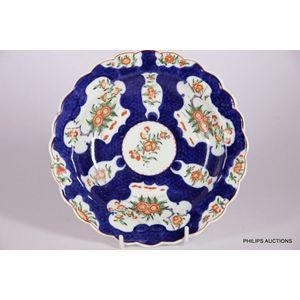Worcester Blue Ground Plate with Kakiemon Pattern
You must be a subscriber, and be logged in to view price and dealer details.
Subscribe Now to view actual auction price for this item
When you subscribe, you have the option of setting the currency in which to display prices to $Au, $US, $NZ or Stg.
- Kakiemon Porcelain - Kakiemon porcelain was made from the 16th to the 19th century in the Arita area of Japan, and is generally agreed to include some of the finest porcelain made in Japan. It is decorated with polychrome enamels over glaze, the most popular colours being underglaze blue and enamels of green, blue, turquoise yellow and persimmon red.
The body of a Kakiemon object is pure white porcelain while the enamel overglaze motifs incorporate Japanese and Chinese designs, but leave much of the white surface unpainted. The name derives from the family of potters who are associated with this style of pottery.
Early Kakiemon porcelain was unmarked, and marks on later objects were variable and unreliable.
Kakiemon porcelain was first imported into Europe by the Dutch at the end of the 17th century, and became extremely popular, resulting in Kakiemon-style imitations being produced by European potteries including Bow, Chelsea and Worcester in England, Mennery, Samson and St. Cloud in France, Delft in Holland and Meissen in Germany.
It's rare for an original Kakiemon object to come onto the market, and almost all sold nowadays is of European origin, and described as Kakiemon pattern or Kakiemon style. - Circa - A Latin term meaning 'about', often used in the antique trade to give an approximate date for the piece, usually considered to be five years on either side of the circa year. Thus, circa 1900 means the piece was made about 1900, probably between 1895 and 1905. The expression is sometimes abbreviated to c.1900.
This item has been included into following indexes:
Visually similar items

A Dr Wall Worcester blue scale dish, circa 1770, decorated with three large rococo reserves and small cloud and vase reserves each with kakiemon style iron red chrysanthemums, upon a deep scale blue ground; bordered fret mark underside, diameter 22.5 cm

An antique English blue and white meat dish, 19th century, rectangular with canted corners, the centre decorated with a Chinese river landscape with buildings, the border with flowering foliage, indistinct mark within a foliate cartouche underside, fitted

A Japanese 19th century Imari ware blue & white plate, C1850 Provenance: Private Sydney collector, purchased in 1960's Kyoto, with original receipt 31 cm diam

A Worcester Dr Wall porcelain plate, circa 1770-1780, with scale blue border, the cartouche painted with floral sprays on a white field within gilt scroll borders, hatched square mark, 19 cm diameter.
